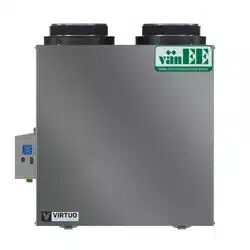Loading ...
Loading ...
Loading ...

6
VH0165
A
B
S
TALE
AIR
FROM
BUILDING
:
Install registers in areas where contaminants and humidity are
produced: kitchen, bathrooms, laundry room, etc.
Install registers on an interior wall, 6 to 12 inches away from
the ceiling OR in the ceiling.
Install the kitchen register at least 4 feet away from the range.
Bathroom fans and range hoods can be used to better exhaust
stale air.
Homes with more than one level require at least one exhaust
register at the highest level.
F
RESH
AIR
TO
BUILDING
:
Install registers in bedrooms, dining room, living room and
basement.
Install registers in the ceiling OR high on the walls with the
airfl ow directed towards the ceiling.
If a register must be installed in the fl oor, direct the airfl ow up
the wall.
2.2.1 F
ULLY
D
UCTED
S
YSTEM
(T-1) (T
HIS
CONFIGURATION
ALLOWS
RECIRCULATION
MODE
TO
OPERATE
.)
2.2 I
NSTALLING
THE
D
UCTWORK
AND
THE
R
EGISTERS
Never install a stale air exhaust register in a room where there is a combustion device, such as a furnace, gas
water heater, fi replace or any appliance or equipment that can generate gaseous contaminants, or pollutants.
The negative pressure this could create in the room may impair proper evacuation of the gas or pollutants,
which may have severe health consequences.
WARNING
!
S
TALE
AIR
FROM
BUILDING
:
Same as for Fully Ducted System, described on point 2.2.1.
F
RESH
AIR
TO
BUILDING
:
Connect the fresh air distribution duct of the unit to the central
forced-air system return duct at least 10 feet away from the
central forced-air system (A+B)*.
* This 10-ft. distance applies only in areas where the outside
temperature falls below the freezing point 0°C (32°F).
NOTE: The central forced-air system blower operation can be
synchronized with the unit (see Section 3.3). It is recommended, but
not essential that the central forced-air system blower runs when
the unit is in operation.
2.2.2 E
XHAUST
D
UCTED
S
YSTEM
(T-2) (T
HIS
CONFIGURATION
ALLOWS
RECIRCULATION
MODE
TO
OPERATE
.)
Duct connection to the central forced-air system can be regulated by some codes and standards. It is your
responsibility to consider and comply with your local requirements to avoid any non-compliance.
WARNING
!
NOTE: For this type of confi guration, the T-1 option must be selected on the LCD screen when auto-balancing the unit.
NOTE: For this type of confi guration, the T-2 option must be
selected on the LCD screen when auto-balancing the unit.
Stale air from
bathroom
Fresh air to
building
Stale air to
outdoors
Fresh air from
outdoors
If ducts have to go through an unconditioned space (e.g.: attic), always use insulated ducts to prevent condensation
formation inside and outside ducts, which could cause material damage and/or mold growth. Moreover, if
fresh air to building duct and/or stale air from building duct goes/go through an unconditioned space, the unit
must be set to operate continuously in cold conditions (below 10°C/50°F). Continuous air movement inside
ducts will prevent condensation formation. The unit can be stopped temporarily for maintenance and/or repair
purposes in such conditions.
CAUTION
A+B=
MIN
10’
Loading ...
Loading ...
Loading ...
